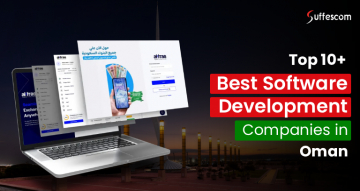Software Development Cost in UAE | Saudi Arabia | Kuwait (2025 Edition)

The software development industry across the GCC is entering a phase of rapid evolution, driven by massive digital transformation goals and robust economic backing. A recent Statista report says that the software market revenue in the Middle East and Africa is predicted to rise to $19.78 billion in 2025, and its growth in the Gulf region is largely boosted by city projects, government digital moves, and rapid digitisation.
This regional surge prompts businesses to precisely assess what type of software they want to develop and how much it would cost. When developing new software or upgrading existing one, several factors highly impact the cost, including the timeframe for completion, complexity, and the product’s quality. Every country comes with its own advantages, for example, Dubai's advanced technology, Riyadh's government-driven innovation, and Kuwait’s affordable ways to build.
This guide examines the software development cost in UAE, Saudi Arabia, and Kuwait in 2025, providing a clear description of the factors that drive the economy, project pricing, relevant laws, and real-world cases. No matter if you are launching a software or a full platform, this comparison will enable you to decide well, based on what is important to you.
Let's begin by understanding the regional landscape shaping these tech ecosystems.
Understanding the Software Development Landscape in the GCC
In the Gulf, software development services are emerging rapidly due to the nationwide digital strategies, efforts towards economic diversity, and the demand for unique digital services. These countries boast high GDP per capita, have strong infrastructures, and the demand for digital solutions is constantly increasing.
Economic Overview of UAE, Saudi Arabia, and Kuwait
Strengthening economic growth in the UAE, Saudi Arabia, and Kuwait will ultimately benefit their tech systems.
- UAE: With a strong GDP and pro-innovation approach, there is a high number of tech startups and recruitment of international developers for the latest projects. Because there are multiple free zones in both cities, running a software business gets easier.
- Saudi Arabia: In line with Vision 2030, Saudi Arabia has substantially improved its digital infrastructure by investing a substantial amount of money. Riyadh’s technology sector is experiencing a fast increase in people developing ideas and investments from all over the world.
- Kuwait: Although Kuwait’s market is not as big, the country is rapidly improving under its Vision 2035 plan. Due to increased aid for digital businesses by the government, Kuwait is an attractive place to develop software at a reasonable price.
Digital Transformation Trends
Government-backed innovation initiatives are reshaping public services and creating an expanding market for software products.
- Smart Cities: Projects like Dubai Smart City, NEOM in Saudi Arabia, and Kuwait Vision 2035 are increasing the need for custom software incorporated with IoT, AI, and analytics, which is always growing to support digital governance and urban automation.
- Enterprise Tech Expansion: From e-governance portals and Artificial Intelligence for customer support, to a greater focus on security and data, which has made localised software development services more necessary.
Primary Factors Affecting Software Development Costs
Learning about the elements that drive software development costs in Kuwait, Saudi Arabia, and the UAE plays a very crucial role for any firm thinking of developing or outgrowing their software solutions in 2025. Below are the most important factors influencing pricing across the region.

Talent Market Dynamics
The biggest cost driver is people. Developer salaries always depend on their skill set, relevant experience, and location.
Developer Salaries
- In the UAE, senior developers earn premium salaries due to high demand and the cost of living.
- Saudi Arabia’s salaries are growing rapidly as demand increases across sectors.
- Kuwait offers slightly lower rates but faces limited availability of senior-level developers.
Developer Availability
- The UAE benefits from a large and skilled expert workforce.
- Saudi Arabia is constantly investing in upskilling local talent through Vision 2030 initiatives.
- Kuwait is operating on constructing a more robust developer ecosystem.
Remote and Hybrid Work Impact
- Companies are blending local and international teams.
- Hiring remote developers from other regions can reduce costs.
- Hybrid models are common across the UAE and Saudi Arabia, but less so in Kuwait
Infrastructure and Operational Costs
The software development cost in Saudi Arabia, UAE, and Kuwait goes beyond writing code because it also includes the physical and digital infrastructure that teams rely on daily.
Office Space & Utilities
- Dubai and Riyadh are among the most expensive cities for office rent.
- Kuwait offers more affordable spaces, but fewer tech-centric business zones.
Cloud Services and Tools
- Expenses for cloud infrastructure (AWS, Azure) change depending on the usage and provider.
- Jira, GitHub, and Figma incur recurring software development costs because they are subscription-based.
- The UAE has better access to enterprise cloud partners than Kuwait or Saudi Arabia.
Hardware and Connectivity
- High-speed internet and device procurement can increase upfront investment.
- Government support in the UAE often offsets some setup costs for tech businesses
Regulatory Environment
Policy differences between GCC countries can impact setup, taxation, and employee benefits.
Business Setup & Licensing
- The UAE offers free zones with simplified licensing processes and tax exemptions.
- Saudi Arabia has made improvements, but it still involves more bureaucratic steps.
- Kuwait’s processes are improving, but they can still delay project kickoff.
Freelancing and Contracting Rules
- In the UAE, freelancers can register under certain visas and platforms.
- Saudi Arabia allows freelance licenses under government programs.
- Kuwait is stricter, often favouring full-time employment over contract work.
Corporate Tax and VAT
- The UAE remains relatively tax-friendly, though VAT and corporate taxes are evolving.
- Saudi Arabia enforces 15% VAT and has recently introduced corporate taxation.
- Kuwait has no income tax but may impose social security contributions.
Market Demand and Competition
Higher demand usually means higher costs, especially in saturated markets.
Developer Supply vs Demand
- The UAE has many startups and large enterprises competing for talent.
- Saudi Arabia’s digital expansion fuels hiring pressure.
- Kuwait’s demand is increasing, especially in the fintech and logistics sectors.
Tech Ecosystem Maturity
- Dubai hosts global accelerators and innovation hubs.
- Riyadh is building large-scale government-led innovation clusters.
- Kuwait is at an early stage but has growing support for SMEs and tech startups.
Outsourcing Trends
- Nowadays, businesses are outsourcing software developers for speed and efficiency.
- Outsourcing helps cut development costs but may create timezone and communication challenges.
Project Complexity and Scope
More software complexity requires more costs and resources.
Simple vs Mid-Level vs Complex Software Solutions
- Basic software costs far less than an enterprise-based software solution.
- Mid-level software solutions or other complex software would require larger teams and longer timelines.
| Complexity Level | UAE (AED) | Saudi Arabia (SAR) | Kuwait (KWD) |
| Simple Software | AED 50,000 – 100,000 | SAR 40,000 – 90,000 | KWD 35,000 – 80,000 |
| Mid-Level Software | AED 100,000 – 200,000 | SAR 90,000 – 170,000 | KWD 75,000 – 160,000 |
| Complex Software | AED 200,000 – 350,000 | SAR 170,000 – 320,000 | KWD 150,000 – 300,000 |
Design and User Experience
- Custom software often demands tailored workflows and interfaces to match specific business processes.
- Countries with better access to creative and UX professionals (like the UAE) can deliver better outcomes at higher prices.
Third-Party Integrations
- Combining custom software with third-party systems, such as accounting platforms, cloud storage providers, or APIs, requires careful planning.
- The more integrations required, the more hours software developers need to invest.
Timeframe and Delivery Urgency
Timeline and software delivery also play a crucial role in deciding the total software development costs in UAE, Saudi Arabia, and Kuwait.
Timeline Pressure
- Shorter deadlines often lead to overtime pay or larger teams, increasing software development costs in Kuwait, Saudi Arabia, and UAE.
- Fast-tracked software projects are common in Dubai, especially in the real estate and finance sectors.
Project Planning
- Longer development cycles allow better resource distribution and cost control.
- Businesses in Saudi Arabia and Kuwait often take a more phased approach to deployment.
Technology Stack and Tool Licensing
Choosing the required tech stack and tools also helps in defining the overall software development cost in Saudi Arabia, the UAE, and Kuwait.
Open-Source vs Enterprise Tools
- Open-source tools like Laravel or React Native can reduce licensing costs.
- Tools like Microsoft Azure, Oracle, or Salesforce increase monthly or annual costs.
Emerging Tech Usage
- UAE companies often utilise cutting-edge technologies such as AI/ML, IoT, or blockchain.
- Saudi Arabia is rapidly integrating smart technologies across government projects.
- Kuwait tends to adopt stable, proven stacks that keep development more cost-efficient.
Thinking about your next software project?
Get a detailed quote tailored to your business goals and budget.
Comprehensive Cost Breakdown for Software Development
Comprehending how software development costs in UAE, Saudi Arabia, and Kuwait break down by developer skill, project complexity, and extra components can help you budget effectively. Here is an overview of cost factors for common software projects in 2025.
Developer Cost by Level and Skillset
Developer rates vary based on skill, experience, and specialisation. These differences affect both upfront and long-term project budgets.
Junior Developers
- Typically handle foundational tasks like frontend elements and testing assistance.
- Best suited for basic software projects or to support larger teams.
Mid-Level Developers
- Involved in complete software development, API integrations, and scalable solutions.
- Offer the best balance between cost and capability.
Senior Developers and Tech Leads
- Responsible for project architecture, team mentoring, and complex problem-solving.
- Critical for enterprise-level builds or systems needing long-term sustainability.
Specialised Skillsets
- Experts in AI, machine learning, blockchain, and cybersecurity usually demand higher compensation.
- Their roles often come into play for industry-specific or innovative tech builds.
Industry-Specific Software Development Costs (2025)
Here’s a typical cost range for software projects in each country, illustrating the impact of complexity and scale.
| Industry | UAE (AED) | Saudi Arabia (SAR) | Kuwait (KWD) |
| Healthcare Software | AED 660,600 – 1,101,000 | SAR 660,600 – 1,101,000 | KWD 660,600 – 1,101,000 |
| Financial Software | AED 367,000 – 734,000 | SAR 367,000 – 734,000 | KWD 367,000 – 734,000 |
| Retail Software | AED 220,200 – 440,400 | SAR 220,200 – 440,400 | KWD 220,200 – 440,400 |
| eCommerce Software | AED 256,900 – 550,500 | SAR 256,900 – 550,500 | KWD 256,900 – 550,500 |
| Educational Software | AED 183,500 – 367,000 | SAR 183,500 – 367,000 | KWD 183,500 – 367,000 |
| Tourism Software | AED 330,300 – 660,600 | SAR 330,300 – 660,600 | KWD 330,300 – 660,600 |
| Real Estate Software | AED 293,600 – 587,200 | SAR 293,600 – 587,200 | KWD 293,600 – 587,200 |
| Logistics Software | AED 367,000 – 734,000 | SAR 367,000 – 734,000 | KWD 367,000 – 734,000 |
| HRMS Software | AED 29,384 – 91,825 | SAR 29,384 – 91,825 | KWD 29,384 – 91,825 |
| CRM Software | AED 55,095 – 99,171 | SAR 55,095 – 99,171 | KWD 55,095 – 99,171 |
| ERP Software | AED 40,403 – 73,460 | SAR 40,403 – 73,460 | KWD 40,403 – 73,460 |
| Email Marketing Software | AED 29,384 – 62,441 | SAR 29,384 – 62,441 | KWD 29,384 – 62,441 |
| Project Management Software | AED 36,730 – 99,171 | SAR 36,730 – 99,171 | KWD 36,730 – 99,171 |
| Accounting Software | AED 47,749 – 73,460 | SAR 47,749 – 73,460 | KWD 47,749 – 73,460 |
| MarTech Software | AED 29,384 – 77,133 | SAR 29,384 – 77,133 | KWD 29,384 – 77,133 |
| Visual Website Builder | AED 33,057 – 80,806 | SAR 33,057 – 80,806 | KWD 33,057 – 80,806 |
| Super App Development | AED 80,000 – 240,000 | SAR 80,000 – 240,000 | KWD 80,000 – 240,000 |
| AI/ML Integration | AED 20,000 – 80,000 | SAR 20,000 – 80,000 | KWD 20,000 – 80,000 |
| Multi-Payment Gateway Integration | AED 15,000 – 30,000 | SAR 15,000 – 30,000 | KWD 15,000 – 30,000 |
| GPS & Navigation Integration | AED 15,000 – 30,000 | SAR 15,000 – 30,000 | KWD 15,000 – 30,000 |
Additional Cost Components
Beyond industry-specific software costs, there are additional expenses which include:
- Quality Assurance & Testing: Quality assurance and testing can increase the total cost of software development by 15-20 percent, depending on the nature and complexity of the software being developed (financial or healthcare applications, in particular).
- Maintenance and Support: Ongoing maintenance costs are 15-25 percent of the initial development costs.
- Third-Party Integrations: API integrations with payment gateways, CRM, analytics, or cloud services typically deal with some licensing cost.
- Project Management: Agile teams usually allocate 10-15% of the project budget for PM to ensure timelines and quality.
- Licensing and Software Infrastructure: Chosen tech stack (cloud hosting, APIs, frameworks) impacts both short-term setup and long-term operational budgets.
Quality, Talent Pool, and Tech Ecosystem Comparison
A tech ecosystem and robust talent pipeline are very important for delivering high-quality software efficiently. Here’s how the UAE, Saudi Arabia, and Kuwait compare.
Developer Education and Training Facilities
- UAE: Home to leading universities, plus numerous coding bootcamps and government-sponsored upskilling programs. The country highly emphasises tech education and innovation labs to keep talent aligned with industry needs.
- Saudi Arabia: Notable investments in STEM education, which include initiatives like the Saudi Digital Academy, focus on emphasising local software development talent. Furthermore, Saudi Arabia's Vision 2030 assists public-private partnerships to help future developers.
- Kuwait: Smaller educational ecosystem with fewer specialised tech programs. However, Kuwait University and private institutes are expanding offerings, focusing on bridging skill gaps in software and cybersecurity.
Popular Technology Stacks in Each Country
- UAE: The UAE is using cloud-native applications (Microsoft Azure and AWS), frontend projects built with React and Angular, as well as backend services that use Node.js and Java Spring. More people are showing interest in AI and blockchain.
- Saudi Arabia: In Saudi Arabia, most of the focus is on using scalable enterprise software systems and platforms that the government likes, such as systems built on Microsoft and Oracle. More utilisation of AI, cybersecurity, and IoT in NEOM and other smart cities is being highly encouraged.
- Kuwait: Business owners in Kuwait are more inclined towards utilising open-source technologies like PHP/Laravel, Python/Django, and MySQL because they are more cost-effective. Although cloud-based usage is increasing, it is still far behind that of the UAE and Saudi Arabia.
Outsourcing Trends and Remote Software Development
- UAE: A hub for outsourcing, with many firms engaging both local and international remote teams. Flexible regulations support freelance and remote work models, helping startups scale rapidly.
- Saudi Arabia: Growing interest in outsourcing but with more regulatory caution around data privacy and localisation. Remote work is rising post-COVID, but on a controlled scale.
- Kuwait: Outsourcing is a common strategy to manage costs. Remote development is widely adopted by startups and SMEs due to budget constraints.
Comparing Software Development Pricing Models Across UAE, Saudi Arabia & Kuwait
| Pricing Model | Commonly Used In | Ideal For | Key Advantages |
| Fixed Price | Kuwait | Small to mid-size projects with clearly defined scope | Cost predictability and simplified budgeting |
| Dedicated Team | UAE, Saudi Arabia, Kuwait | Enterprise software, long-term product development | Consistent team, deep domain expertise, full control |
| Hybrid Model | UAE & Saudi Arabia | Mixed-scope projects (fixed and agile parts) | Balanced control over costs and adaptability |
Exploring the Different Types of Custom Software Solutions for Modern Businesses
Selecting the proper custom software can have a big effect on the efficiency of your business. Let’s examine here the most popular kinds of custom software that help companies prosper.
- In-house business software: In-house business software helps in project management systems, HR tools, and communication apps, supporting your teams in staying together and producing good results. The type of software solutions is to make things easier and enhance how you work on a daily basis.
- Business Process Automation: The focus of Business Process Automation (BPA) software is on efficiency. It replaces manual tasks with automated workflows, thus reducing errors and making things much quicker. No matter if the company needs to process invoices or add new employees, BPA tools facilitate growth and make both tasks more efficient.
- Scalable Systems for Large Enterprises: Such software is made to address the challenges of large organisations. These solutions integrate various business functions, such as HR, accounting, customer service, and supply chain, into a single, cohesive system. For example, ERP software helps manage activities such as inventory, buying items, and planning the budget.
- Seamless Integration Across All Platforms: These software solutions allow your systems to interact and work together appropriately. To give an example, a grocery delivery business would rely on middleware to connect its order management, warehouse, and delivery departments, making sure updates are always in real time and the process is seamless.
- Tailored Software for Specific Industries: There are different challenges, rules, and processes in every business industry. Software that focuses on businesses in various domains, such as healthcare, finance, retail, or manufacturing, is designed with those unique demands in mind. Most of these solutions are set up with compliance features, data safety measures, and tools that automate tasks common in the industry.
Benefits & Challenges of Software Development in Each Country
Each GCC country presents various advantages and hurdles that affect software development projects differently. Knowing about these helps in making an informed choice.
UAE
- Benefits
The UAE has a world-class infrastructure, tax-friendly free zones with advanced digital ecosystems that attract global tech talent and investors. Because of its location and good connections, the region is an excellent place for regional and international software companies.
- Challenges
Labour costs in the UAE are among the highest in the GCC. Because there are so many companies seeking skilled developers, their pay has increased, and many companies now find it challenging to keep their employees. Additionally, business setup in free zones may come with restrictions depending on the sector.
Saudi Arabia
- Benefits
Saudi Arabia’s large domestic market and strong government want to move ahead with digital development, and the potential for growth is very high. Programs like Vision 2030 boost innovation and lead to a demand for top-level software solutions.
- Challenges
Regulatory complexities and Saudi policies can slow hiring and increase compliance costs. There are not enough skilled people trained in the region, so companies must hire from abroad, which increases the budget.
Kuwait
- Benefits
Software development in Kuwait is cost-effective because both labour and operational costs are low. The government’s Vision 2035 helps build up entrepreneurship and assists local tech businesses in growing.
- Challenges
The technology ecosystem is still developing, as there is not much sophisticated planning and not many ways to get training. The smaller market size can restrict scalability and investment prospects compared to the UAE and Saudi Arabia.
Legal And Compliance Considerations
Following the laws and regulations makes sure that the process operates smoothly and helps you avoid high fines.
Data Privacy Laws
Stricter data protection rules must be followed by every enterprise and financial establishment to keep vital information safe.
- UAE: The DIFC Data Protection Law in the UAE provides guidelines for handling and storing data set by European and other global requirements, such as the GDPR.
- Saudi Arabia: According to the PDPL in Saudi Arabia, organisations that process personal data need to set strong security measures and report any breaches.
- Kuwait: In Kuwait, the government aims to comply with its data privacy laws by developing projects that adhere to international guidelines.
Intellectual property protection
Protecting software intellectual property helps a business remain competitive and attract investments.
- Although laws are in place in the GCC to support copyrights, patents, and trade secrets, their enforcement can change.
- Each company ought to make sure its trademarks and software patents are registered and noted on all contracts they agree to.
Contract Enforcement and Dispute Resolution
Strong legal contracts and accessible dispute resolution mechanisms help avoid costly delays and litigations.
- The UAE offers efficient arbitration centres and business-friendly courts, especially within free zones.
- Saudi Arabia and Kuwait also provide arbitration options, but may have longer legal processes.
Compliance with Industry-Specific Standards
Guaranteeing compliance with industry-specific standards helps to reduce overhead costs while maintaining standards.
- Any kind of financial and healthcare software must meet the rules of ISO 27001, PCI DSS, and any local cybersecurity laws.
- Businesses are required to follow secure coding, test for weaknesses, and audit often to meet the requirements and earn their customers’ trust.
How to Choose the Best Location for Your Software Development in 2025
You have to consider the country for your project to get a better idea of the total software development cost.
Key Decision Factors
- Budget Constraints: Budget considerations should include labour as well as all fees and expenses related to running and legal issues for the business.
- Project Complexity: Some projects are very complex and may therefore depend on the use of advanced skills and resources.
- Desired Speed to Market: Some places make it possible to start your business and get software to the market faster.
- Talent Availability: The ready supply of seasoned developers and training centres has an impact on how effective a project can be and how large it can become.
- Legal and Tax Environment: Risks and costs can be addressed through good regulatory policies and tax breaks from the government.
Decision Matrix
Criteria | UAE | Saudi Arabia | Kuwait |
| Cost Efficiency | Medium | High | Medium |
| Availability | High | Medium | Low |
| Regulatory Ease | High | Medium | Medium |
| Infrastructure | High | Medium | Low |
| Speed to Market | High | Medium | Medium |
Use this matrix as a starting point, then tailor your assessment based on your unique project needs and business goals.
Conclusion
In summary, when selecting a place for software development in UAE, Saudi Arabia, or Kuwait, one must check factors such as how much it will cost, the skill levels of the people, infrastructure, and the regulatory situation.
Although the UAE has excellent technology and infrastructure and skilled workers, it also has higher expenses. Furthermore, due to the strong policies of the Saudi Arabian government, the country’s market offers considerable potential for businesses willing to navigate complex laws. Startups and smaller business projects can thrive in Kuwait because it is economically affordable, yet there are some setbacks when it comes to infrastructure and resources.
With a keen understanding of your project’s difficulty, how much money it will take, and how quickly the software will fulfil your requirements, you can wisely choose the location for your needs. For enterprises focused on cybersecurity in their software development lifecycle, adopting industry standards and employee training programs is crucial.
If you are still doubtful about where to start? Then contact us today to get a clear overview!
Plan Your 2025 Software Budget
Get ahead of the curve with our expert tips for budgeting software development costs in the GCC region.
FAQs
1: What is the average hourly rate for software developers in the UAE, Saudi Arabia, and Kuwait?
The average hourly rate for software developers in UAE, Saudi Arabia, and Kuwait varies by experience and technology, but typically:
- UAE: AED 150 – 400 per hour
- Saudi Arabia: SAR 120 – 350 per hour
- Kuwait: KWD 30 – 90 per hour
(UAE rates tend to be higher due to demand and living costs; Kuwait generally offers the most competitive rates.)
2: How much does a simple website development project cost in each country?
A simple website development project costs in each country would be:
- UAE: AED 15,000 – 40,000
- Saudi Arabia: SAR 12,000 – 35,000
- Kuwait: KWD 3,500 – 9,000
3: What factors cause software development costs to vary significantly within these countries?
Factors that cause software development costs to vary within countries include:
- Developer seniority and specialisation
- Project complexity and features
- Use of third-party software/licenses
- Project management and testing requirements
- Location of development team (onsite vs remote)
4: Are fixed-price or hourly billing models more common in the UAE, Saudi Arabia, and Kuwait?
Both fixed-price and hourly billing models are common in the UAE, Saudi Arabia, and Kuwait, but:
- Hourly rates are common for long-term or flexible scope projects.
- Fixed-price contracts are preferred for well-defined projects to control budgets.
Negotiations depend on client preferences and project nature.
5: How much should I budget for an average mobile app development project in these countries?
An average mobile app development project in these countries typically ranges from medium-complexity apps.:
- UAE: AED 80,000 – 250,000
- Saudi Arabia: SAR 70,000 – 220,000
- Kuwait: KWD 20,000 – 60,000
These costs include UI/UX, backend, testing, and deployment.
6: Does the cost of software development include ongoing maintenance and support?
Usually not. The cost of ongoing maintenance and support is often billed separately, typically 10-20% of the initial development cost annually, covering bug fixes, updates, and minor enhancements.
7: How does hiring in-house developers versus outsourcing affect software development costs?
In-house hiring requires higher upfront investment (recruitment, benefits, office space) but offers better control. Outsourcing reduces fixed overheads but may incur management and communication costs. Costs vary widely depending on the country and vendor.
8: How do taxes and VAT affect overall software development costs in the UAE, Saudi Arabia, and Kuwait?
VAT rates in the GCC vary (e.g., UAE and Saudi Arabia currently at 5-15%), which can add to project costs. Some free zones in the UAE offer VAT exemptions, which may reduce expenses.
9: Is software development cheaper in Kuwait compared to the UAE and Saudi Arabia?
Generally, yes, Kuwait tends to have lower software development costs due to a smaller market size and lower labour costs. However, limited talent availability can sometimes extend project timelines, indirectly increasing costs.
10: How much does adding advanced features like AI or blockchain increase software development costs in these countries?
Advanced features like AI or blockchain increase software development costs by 10-20% because AI/ML or blockchain development requires specialised expertise and longer development cycles, significantly raising budgets.
11: How will emerging technologies like AI, blockchain, and IoT impact software development costs in the GCC by 2025?
Incorporating emerging technologies like AI, blockchain, and IoT typically increases development costs due to specialised skills needed. However, automation and AI tools are also expected to improve efficiency, potentially balancing out costs over time.
12: Will the adoption of cloud-native and serverless architectures change software development pricing models in these countries?
Yes. The adoption of cloud-native and serverless architecture reduces infrastructure overhead but requires developers skilled in these paradigms, which may command higher salaries. Over time, these architectures can lower the total cost of ownership.
13: What role will government initiatives like Saudi Vision 2030 and the UAE’s Smart City projects play in shaping future software development costs?
The government initiatives like Saudi Vision 2030 and the UAE’s Smart City projects are accelerating demand for high-tech solutions, increasing competition for skilled developers, and potentially driving costs up. Conversely, subsidies and tax incentives may offset expenses for qualifying projects.
14: Are there upcoming regulatory changes in data privacy or cybersecurity that might increase software development costs in these countries?
Yes. Stricter data protection laws (e.g., Saudi Arabia’s PDPL) require additional compliance work, security audits, and certifications, which can increase development and maintenance costs.








